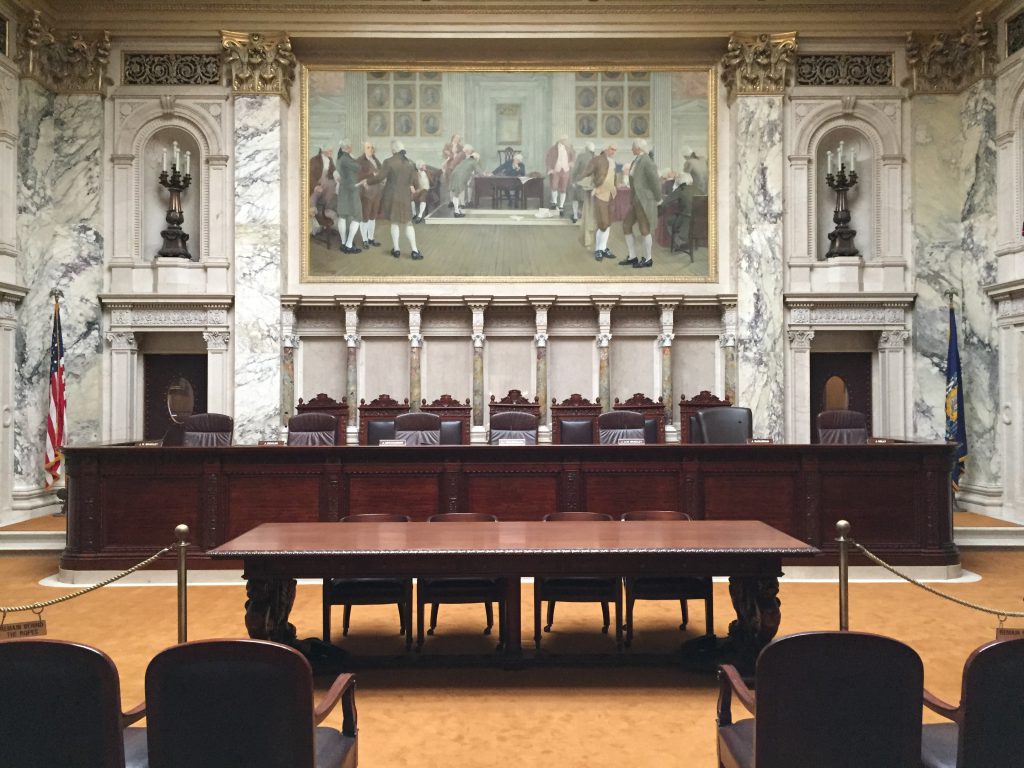WI Supreme Court Hears Challenge to Latest COVID-19 Order
The suit challenges a statewide restriction on bar, restaurant capacity that already expired.
Wisconsin’s Supreme Court heard arguments Thursday in another case that could reframe the power of state government to respond to the COVID-19 pandemic, reviving a debate that began when justices struck down the state’s “Safer at Home” order in May.
The latest dispute stems from an order restricting bar and restaurant capacity that expired more than a month ago, but it raises issues the court left ambiguous in its “Safer at Home” ruling, and this time, there’s a new justice hearing the case.
Palm’s order restricted the size of crowds at indoor businesses like restaurants and bars. Under the order, those businesses were limited to 25 percent of their usual capacity. For example, a restaurant that could normally hold up to 200 people would be limited to a crowd of 50.
Palm signed the order as COVID-19 cases were surging, making Wisconsin one of the nation’s COVID-19 hotspots and pushing hospital capacity to the brink.
“We know that COVID-19 spreads primarily via close contact and that indoor public gatherings present a particularly acute risk of viral transmission,” said Assistant Attorney General Colin Hector while defending the order during oral arguments Thursday.
Palm’s latest order is separate from the emergency orders issued by Evers to declare and extend Wisconsin’s statewide mask mandates. Those orders are being challenged before the Wisconsin Supreme Court in a different case.
Critics of Palm’s order argue it should be struck down because it relies on part of the same law that the Supreme Court addressed when it struck down “Safer at Home.”
“We have the same agency here. We have the same pandemic. They are repackaging these same exact arguments they made the last time,” said attorney Misha Tseytlin arguing on behalf of the Mix Up, Inc., an Amery bar and grill challenging Palm’s order. “I understand the composition of this court has changed since, but the law hasn’t changed.”
When the court struck down “Safer at Home,” conservatives had a 5-2 majority, but the case was decided on a 4-3 vote with conservative Justice Brian Hagedorn siding with the court’s liberals to support the Evers administration.
Since then, the conservative majority has been trimmed to 4-3 following Justice Jill Karofsky‘s defeat of conservative Justice Daniel Kelly.
Hagedorn has been a swing vote on the court in a handful of high-profile cases, ruling this month against three Republican lawsuits that sought to overturn Wisconsin’s presidential election results.
A critical question in this case could be whether he views the details of this latest order as substantially similar the one the court struck down earlier this year.
“To turn on that now would be to undercut many of the principles that we’ve laid out in the way we conduct ourselves as an institution,” Hagedorn said from the bench Thursday.
The Evers administration argues there’s a key difference in this case.
When the court struck down “Safer at Home,” it carved out an exception, stating without explanation in two footnotes in the majority opinion that it was not striking down the state’s powers to close schools.
The law that spells out the power to close schools states that DHS “may close schools and forbid public gatherings in schools, churches, and other places to control outbreaks and epidemics.” The Evers administration argues that Palm’s latest order did just that.
“In issuing the order, DHS simply decided how to apply its statutory authority to forbid public gatherings to control epidemics,” Hector told justices.
That argument appeared to hold at least some sway with liberal Justice Rebecca Dallet, who said the court’s decision from earlier this year was “internally inconsistent.”
“That is why we’re here today,” Dallet said. “So what do we do?”
The case argued Thursday took some procedural twists and turns on its way to the Wisconsin Supreme Court.
The case was originally filed by the Tavern League of Wisconsin, and the first judge to hear it, Sawyer County Judge John Yackel, sided with the Tavern League almost immediately, issuing a temporary restraining order that blocked the limits on crowd capacity on Oct. 14.
After the case was reassigned, Barron County Circuit Court Judge James Babler sided with the Evers administration, reinstating the limits on Oct. 19.
An appeals court ultimately blocked the ruling on Oct. 23. It was scheduled to expire on Nov. 6.
COVID-19 cases have declined steadily over the past month, dropping from a seven-day average of 6,563 cases on Nov. 18 to 3,247 on Dec. 16.
That’s still higher than when the Evers administration issued its order limiting bar and restaurant capacity. At that time, the seven-day average for new COVID-19 cases was 2,346.
Listen to the WPR report here.
Wisconsin Supreme Court Hears Challenge To COVID-19 Order Limiting Bar, Restaurant Capacity was originally published by Wisconsin Public Radio.






















